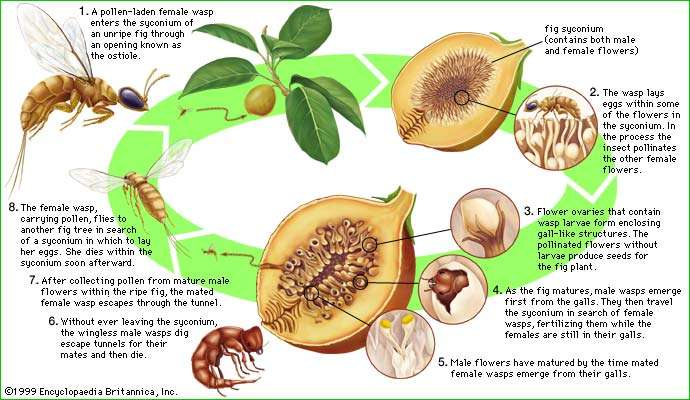By Lane Scher
In 350 BC, Aristotle wrote about wasps crawling out of ripe figs and then tunneling into the figs of another tree in his book, History of Animals. This might have been the first record of the bizarre mutualism between wasps and figs.
Flowers need to be pollinated for a fruit to develop. Unlike most flowering plants, figs flowers grow in a syconium, which is a hollow structure with flowers growing on the inside where pollinators can’t easily get in. The syconia eventually develop into fig fruits, with the help of wasps. This is a great example of a mutualism, which is a relationship between two species that both need the other to survive. In this mutualistic relationship, the fig and the wasp can’t live without each other: the figs get pollinators inside their syconia, and the wasps have a safe place to lay their eggs.
The process starts with a female wasp digging a tunnel into a syconium, carrying pollen from another fig tree. She lays her eggs inside, pollinates the fig flowers, and then dies. Once the flowers have been pollinated, the syconium ripens and becomes a fig fruit with the wasp eggs inside. The male wasps, which don’t have wings, hatch first and mate with their sisters before the females emerge from the eggs. The wingless males then chew holes through the fruit, but since they can’t fly out, they die inside like their mother. When the females finally hatch, their fertilized eggs are already starting to develop. They collect pollen from flowers inside the syconium, and then leave through the tunnels their brothers made. These females, which do have wings, fly to other fig trees, where they tunnel into another syconium and start the process over.

Image obtained from Encyclopaedia Brittanica for non-commercial, educational use. https://www.britannica.com/animal/fig-wasp
Each species of fig is pollinated by a different species of wasp because of coevolution between these two groups over millions of years. Coevolution means that two interacting species evolve together, and changes in one cause changes in the other. For example, if a population of figs evolves to have thicker skin around its syconia, the wasps that pollinate it might evolve sharper mouth parts to help it tunnel through the thicker skin. With enough changes, that could make two new species: thick-skinned figs and sharp-mouthed wasps. Other wasps without sharp mouth parts won’t be able to tunnel into the thick-skinned figs, so you end up with only one species of wasp that can pollinate that species of fig.
Does all this mean that when you eat a fig, you’re eating a bunch of dead wasps? Nope! Figs make an enzyme called ficain, which breaks down the dead wasps and absorbs the nutrients into the developing fig. So you’re not eating the wasps, but you’re eating a fruit that couldn’t exist without them.
Edited by Emma Joy Goldberg and Mike Pablo
